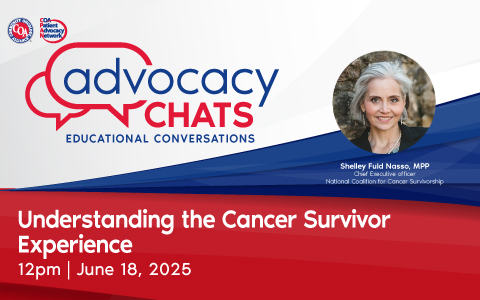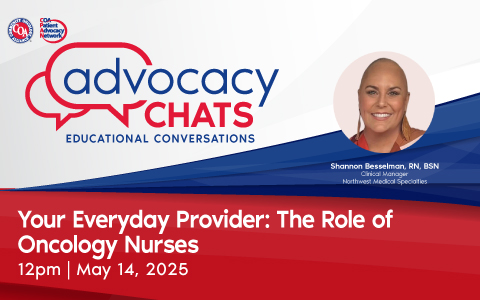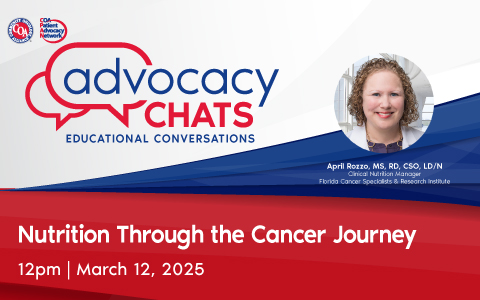Addressing Equity in the Health Care System
Health equity discussions are happening with increasing frequency, and the COVID pandemic has brought equity into sharp focus. Unsurprisingly, leaders in the field discussed their efforts in addressing health disparities as recently as the COA Annual Conference last month. National Minority Health Month, observed every April, underscores the importance of improving health outcomes for racial and ethnic minority groups.
In keeping with that designation, the April 2022 CPAN Advocacy Chat focused on health care disparities. Starting in 2014, the Patient Advocate Foundation carved out Health Equity Initiatives as a major focus for their advocacy efforts. This month’s speaker, Alan Balch, PhD, chief executive officer of the Patient Advocate Foundation and the National Patient Advocate Foundation, brought expertise and history in dealing with health care equity, as well as the experience of the Patient Advocate Foundation, to the discussion.
What is the Patient Advocate Foundation?
The Patient Advocate Foundation (PAF) is a national non-profit organization whose mission is to provide case management services and financial aid to Americans with chronic, life-threatening, and debilitating illnesses. The Foundation delivers hope and help in many ways. In 2021, the Foundation:
- Served 156,000 patients; with family members, PAF served almost 500,000 people
- Obtained $22 million in debt relief for patients
- Provided $350 million in direct financial assistance
- Offered 35 case management programs and 50 financial assistance funds
- Operated with 18 non-profit organizations and academic partnerships
- Supported 30 students through PAF’s academic scholarship program
Foundation programs and services are divided into two categories – Direct Patient Services and Outreach. Direct Patient Services include case management, financial assistance funds, and co-pay relief programs. Those services are expanded through the Outreach programs which include health equity and community engagement; patient impact; special events; health services, research, and patient experience and evaluation; and patient education and empowerment. Each program is evaluated to maximize what can be done from a health equity and diversity perspective.
Health Equity Initiative Launch
In 2014, the Foundation set board level goals with the objective to expand the level at which current and existing PAF programs effectively reach and serve patients facing inequities in the health care system. Organizational goals and metrics were established and an executive leader for the initiative was hired.
The Foundation expanded programs and services to specific patient populations with acute needs based on diversity in both disease and race/ethnicity. Key indicators were set and tracked:
- Serve more patients with different diseases
- Serve more patients from racial and ethnic groups with an emphasis on Hispanic Latinos and African Americans
- Examine and identify relationships with organizations representing racial and ethnic minority groups
- Advance relationships with different patient organizations
- Develop new programs specifically for racial and ethnic minorities
Health Equity Version 1.0 – 2014 – 2019
Shonta Chambers, EVP for Health Equity Initiatives and Community Engagement
Joining the Foundation in 2014, Shonta Chambers brought 20 years of non-profit and public sector middle and senior level experience that spans public health, women’s health, and behavioral health. She was hired to lead the development and execution of strategic initiatives to expand the Foundation’s approach to achieve health equity through community and national level partnership engagement and mobilization. These initiatives link limited income communities to resources to abate financial, logistical, and social access to care barriers.
One Community at a Time
The Foundation has long had the mantra of “one patient at a time.” That was expanded to “one community at a time” when addressing health equity. All health care, like politics, is local and based on regional groups of providers. Care is very dependent on the community in which patients reside, so the issue was not just reaching patients but reaching certain communities.
The Foundation set a goal to increase awareness and availability of case management services among under-resourced, disparate individuals with chronic, life threatening or debilitating diseases in targeted communities. The targeted communities were Memphis, Houston, Chicago, and the state of West Virginia. The targeted health conditions and risk factors were breast and lung cancer, cardiovascular disease, viral hepatitis, and tobacco use.
Live Events
The Foundation created live events within the communities with the health systems and they patients they serve. Initially, the focus was on skilled communications workshops to help local groups understand when and how to link to the Foundation and the broader health care system safety net. The resources in the community and by extension, the national programs like Medicaid and the Foundation’s own case management programs, were part of the events.
Expanded Local Partnership Engagement
The Foundation partnered with many different local organizations.

Health Equity & Community Engagement
Since its inception, PAF’s work has focused on addressing health inequities driven by its service to specific populations experiencing high premature mortality in part because of social determinants of health, or, more specifically, the gaps caused by them. Between 2002 and 2020, the Foundation made considerable progress in reaching underserved communities by increasing outreach in the African American community from 12 percent to 28 percent, in the Hispanic/Latino community from 4 percent to 11 percent, and in the Asian community from 1 percent to 3 percent.
Health Equity Accomplishments
The Foundation was able to:
- Reach more than 1,750 patients and caregivers through three collaborative, innovative outreach events focused on breast cancer, with topics ranging from breast cancer screening and treatment to financial resources and PAF services
- Reach an estimated 10,000 views of a lymphedema educational video produced in conjunction with the Live Today Foundation
- Collaborate with the Memphis Breast Care Consortium for video production to educate Black women on what it means to have a breast cancer diagnosis
The Foundation case management program is a direct, in-depth program that helps with reducing financial burden, enrollment into appropriate insurance, charity, social programs, and by providing insurance navigation. Demographically, the Foundation case management patients are:
- Aged 56 or older (51%)
- Living at or below 250% of Federal Poverty Guidelines (47%)
- Female (66%)
- Insured (89%)
- From a racial minority group (40%)
- Most common diagnoses are cancer, COVID-19, diabetes, cardiovascular diseases, and multiple sclerosis
Health Equity Version 2.0 – 2020 – Current
Top Patient Needs in 2021
In 2021, the top Foundation patient case management needs were:
- Health care costs
- Paying for utilities
- Paying for housing
- Transportation
- Nutritional needs
- Enrolling in Social Security Disability
- Enrolling in insurance
Social Determinants of Health
The Kaiser Family Foundation has identified certain social determinants of health. Those listed in red are the areas where Foundation services overlap, and the Foundation is able to affect patient outcomes and prognosis.
- Economic stability
- Employment
- Income
- Expenses
- Debt
- Medical bills
- Support
- Neighborhood and physical environment
- Housing
- Transportation
- Safety
- Parks
- Playgrounds
- Walkability
- Education
- Literacy
- Language
- Early childhood education
- Vocational Training
- Higher education
- Food
- Hunger
- Access to healthy options
- Community and social context
- Social Integration
- Support systems
- Community engagement
- Discrimination
- Stress
- Health care system
- Health Coverage
- Provider availability
- Provider linguistic and cultural competency
- Quality of care
Center for Disease Control’s (CDC) Health Equity Science & Intervention Strategy
The Foundation uses the CDC’s CORE strategy:
- C CULTIVATE comprehensive health equity science
- O OPTIMIZE intervention
- R REINFORCE and expand workforce engagement
- E ENHANCE capacity and workforce engagement
The Foundation was selected to be part of a Robert Wood Johnson Foundation Equity Learning Lab program. The Equity Learning Lab is designed to generate evidence to support organizations in their mission to internally center equity, which will enable them to drive equity more effectively in their external work.
PAF/NPAF Health Equity Affinity Group
The Foundation formed a Health Equity Affinity Group with the following parameters:
- 13-15 members
- Inform organizational priorities related to addressing health equity
- Strategize how PAF can move towards equity (internal and external)
- Meets quarterly to review organizational progress towards equity goals/benchmarks
- Provides input into PAF organizational equity policies and procedures
- Forum for ongoing, bi-directional communications between executive leadership and staff
The goal was to achieve true outreach by not only working with those who approached the Foundation but also to reach out to those who did not contact the Foundation but did need its help.

Call to Action from the CDC
In November 2020, the CDC expanded the U.S. Diabetes Surveillance System with a new social determinants of health (SDOH) module to help identify under-resourced areas of the United States
- This new tool could help researchers and public health professionals identify and better align available resources to address the needs of people at risk
- The social vulnerability index (SVI) helps to identify communities with limited resources
- Research shows that interventions that improve socio-environmental conditions can lead to better health and reduce health disparities
The Foundation took up the call from CDC to use the SVI because it takes a broad view of social vulnerability and does not just assess one dimension. The SVI helps identify communities with limited resources based on four central themes and 15 variables:
- Socioeconomic status: below poverty, unemployed, income, no high school diploma
- Household composition and disability: persons over age 65, persons under age 17, persons over age 5 with a disability, single-parent households
- Race/ethnicity and language: minority status, ability to speak English “less than well”
- Housing or transportation status: multi-unit structures, mobile homes, crowding, no vehicle ownership, group living quarters
This new tool should help researchers and public health professionals identify and better align available resources to address the needs of people at risk.
Identifying Counties with Highest Social Needs
The Foundation took that idea and identified its own chronic disease index spanning 17 variables in four disease areas:
- Diabetes prevalence
- Cancer incidence rates in five racial and ethnic groups
- Cardiovascular disease deaths in five racial and ethnic groups
- HIV prevalence in six racial and ethnic groups
The Foundation developed an index score as the summation of all categories in which the county met or exceeded a CDC cut point.
PAF Co-Pay Relief Program: Available Health Equity Funds
The Foundation created health equity funds that were targeted to the zip codes within counties that they identified as the most vulnerable and then built out a robust community outreach and engagement chronic disease strategy for:
- Breast cancer
- Coronary artery disease
- Diabetes
- Hepatitis C
- Metastatic colorectal cancer
- Multiple myeloma
- Non-small cell lung cancer
- Ovarian cancer
- Prostate cancer
- Virology testing
PAF followed through by going out into the community rather than adopting an “if we build it, they will come” policy. The social determinants of health, previously mentioned, are all actionable within the health care system. If they are not addressed, they will interfere with patient outcomes.
Introduction to Z Codes
The medical process is comprised of four key features:
- Screening
- Diagnosis
- Intervention
- Monitoring
The healthcare system must be able to do all four things to internalize a problem set. Z codes are a special group of codes provided in ICD-10-CM for the reporting of factors influencing health status and contact with health services. To diagnose and then assign a Z code, providers must first conduct a screening. Once a condition is diagnosed, there is an obligation to treat and then to monitor. Eventually, there will have to be reimbursement for the intervention and monitoring portions of Z code work.
Z-code Expansion Efforts
ICD-10-CM Codes – Z55 through Z65 have been assigned for persons with potential health hazards related to socioeconomic and psychosocial circumstances. They are:
- Z55, Problems related to education and literacy
- Z56, Problems related to employment and unemployment
- Z57, Occupational exposure to risk factors
- Z59, Problems related to housing and economic circumstances
- Z60, Problems related to social environment
- Z62, Problems related to upbringing
- Z63, Other problems related to primary support group, including family circumstances
- Z64, Problems related to certain psychosocial circumstances
- Z65, Problems related to other psychosocial circumstances
There is also a move to expand Z codes even further so data such as the following can be captured. For example, Z59: problems related to housing and economic circumstances, can be expanded to track more refined data such as:
- 41, Lack of adequate food
- 42, Food insecurity
- 43, Lack of safe drinking water
- 61, Unable to pay for prescriptions
- 62, Unable to pay for utilities
- 63, Unable to pay for medical care
- 64, Unable to pay for transportation for medical appointments or prescriptions
- 65, Unable to pay for phone
- 66, Unable to pay for adequate clothing
- 67, Unable to find or pay for childcare
- 69, Unable to pay for other needed items
- 91, Worried about losing housing

A Delivery Model for Person-Centered Care
Person-centered care begins with Shared Decision Making, which is the expression of personalized goals, needs, and preferences matched against personalized treatment options. The next step is Care Planning to develop a goal concordant care plan that identifies social support and care navigation needs. Finally, there is Measurement through data collection and sharing to track adherence and progress combined with patient reporting on quality of life, functional status, health status, and safety.
The health care system is good at doing things “to” people. What is needed here is doing things “with” and “for” people, an area where the system has less experience and less expertise. Because these issues touch a patient’s home life and other intimate factors, a level of trust must be built, or patients will be uncomfortable or unwilling to have a discussion.
Three factors shape a good patient experience:
- Respect – seeing and treating each person as an individual without making assumption or judgements
- Listening – a genuine two-way discussion, not just dictating treatment or “hearing without actually listening”
- Personal Connection – wanting a relationship, or to be acknowledged on a personal level by a doctor or other provider
The ultimate goal is to build trust, both with individual patients and within their communities. Without trust, social determinants of health cannot be utilized in treating patients.
Elements of Patient/Provider Trust
Trust is an essential component of any interpersonal relationship, but it is particularly integral to the relationship between patients and their physicians. Patient-physician trust increases willingness to seek treatment, disclose sensitive information, adhere to medical recommendations, and share decision-making authority. Health care as an industry, and as a set of providers, is particularly vulnerable to deficits of trust. Trust and reputation are important indicators of institutional health at both the provider and facility level.
Additional Information
There is additional information available at:
May is National Clinical Trials Month and accordingly, the next Advocacy Chat, on Wednesday, May 11, 2022, 12:00 PM – 12:30 PM ET, will discuss Clinical Trials in the Community Oncology Setting.
CPAN Advocacy Chats are regular virtual events where a guest speaker is invited to join us to discuss issues important to advocacy and advocates in a 30-minute webinar.
CPAN Advocacy Chats are regular virtual 30-minute educational conversations about cancer advocacy and policy with a guest speaker invited to discuss issues important to patients and advocates. Summaries of previous Advocacy Chats are available on the CPAN website.
Past Advocacy Chats





